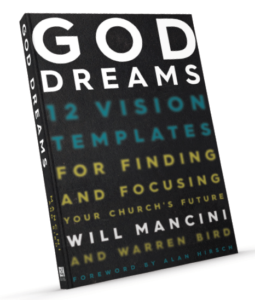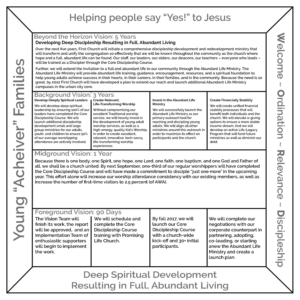 There’s a saying, no one seems to know who said it first, that “If you’re the smartest person in the room, you’re in the wrong room.” I try to stay out of those rooms whenever possible. So it wasn’t surprising to me when I found myself in the same room as Will Mancini and Warren Bird at Exponential East, 2017, while they were speaking about their book God Dreams: 12 Vision Templates for Finding and Focusing Your Church’s Future.
There’s a saying, no one seems to know who said it first, that “If you’re the smartest person in the room, you’re in the wrong room.” I try to stay out of those rooms whenever possible. So it wasn’t surprising to me when I found myself in the same room as Will Mancini and Warren Bird at Exponential East, 2017, while they were speaking about their book God Dreams: 12 Vision Templates for Finding and Focusing Your Church’s Future.
God Dreams builds on Mancini’s earlier book Church Unique and is a step-by-step plan to guide church leaders through a vision-creation process.
Although there are six sections in the book, I found three key themes. (1) Why you need a vision and why their process is useful; (2) An explanation of the twelve “Vision Templates,” that is, twelve paradigmatic church vision foci; and (3) How to create and implement a comprehensive vision using their Horizon Storyline tool.
Those familiar with my writings on the creation of a Big Mouse Vision know that I’m not really big on vision-by-committee. I’m more of a “Moses went to the mountain and God gave him the vision,” go and do likewise kind of a guy, but for the sake of research I gave the God Dreams plan a try with a local church.
Here’s what I learned. The God Dreams vision creation process isn’t a quick and easy tool. It’s going to take several protracted meetings. I suspect it could be done on a two or three day retreat, but I would question the energy and creativity level of a visioning team after hours of brainstorming. On the other hand, I’m pretty sure Will and Warren would caution against rushing the process anyway. At least in my opinion, you’ll want a team that’s fresh for each leg of the vision-creation journey. That being the case, if you meet weekly with a team, plan on two to three hour meetings for at least a month. And though that seems like a lot of time, the reality is when your team is done, you should have a clear picture of your congregation’s vision (see image at bottom of post).
In the end, your church vision will include four primary parts.
(1) A “beyond the horizon” vision, which is Mancini-speak for the long-term vision that’s more inspirational picture than measurable goals.
(2) A “background” vision that includes four essential milestones to reach in the next three years.
(3) A “mid-ground” vision that is the ONE big goal your church will accomplish in the next year.
(4) A “foreground” vision that includes four 90-day goals that will move you to your one-year goal.
The book concludes with insights and instructions on how to bring the vision to life in your congregation: don’t cast your vision, drip your vision.
In my opinion, Mancini and Bird have developed an excellent tool for vision creation in a church. In my experience with the church I was working with, by the time we were moving into the mid-ground and foreground work, the vision team was getting a bit tired of meeting together and working through the details, but ultimately they were excited by the end results and I think they have a solid, workable vision.
God Dreams is one of the better tools I’ve used for developing/discerning a congregation’s vision. If you’re committed to a collaborative, team-based kind of vision process, you really can’t go wrong with their process.
BTW, below is the Horizon Storyline that the team created. The Beyond the Horizon vision description that’s shown is a significantly shortened version of the complete story. Click on the image if you want to see it in a version big enough to actually read.


